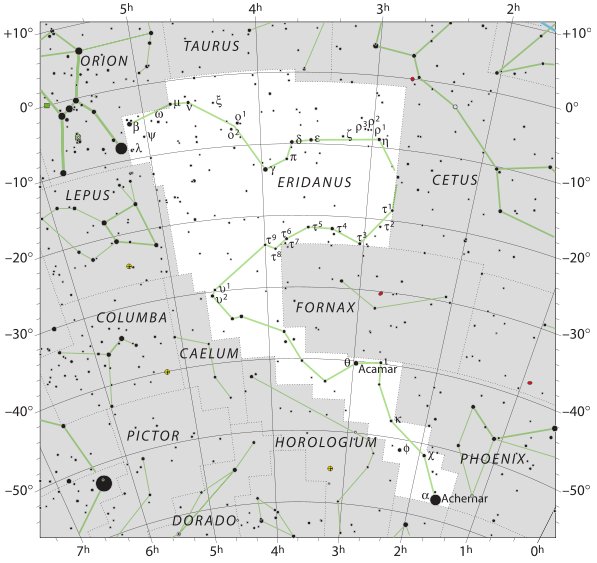1. The following 7 prominent stars
have so far been discussed briefly:
|
Caph |
β
Cassiopeiae |
2.28 |
58º 52'
N |
00h 06m |
1.5 |
62.5 |
|
Sirrah |
α
Andromedae |
2.07 |
28º 49'
N |
00h 06m |
1.5 |
62.5 |
|
Algenib |
γ
Pegasi |
2.83 |
14º 54'
N |
00h 11m |
2.8 |
410.8 |
|
Schedir |
α
Cassiopeiae |
2.24 |
56º 16'
N |
00h 38m |
9.6 |
417.6 |
|
Deneb
Kaitos |
β
Ceti |
2.04 |
18º 16'
S |
00h 41m |
10.4 |
418.4 |
|
Achird |
η
Cassiopeiae |
3.46 |
57º 33'
N |
00h 46m |
11.7 |
419.7 |
|
Cih |
γ
Cassiopeiae |
2.15 |
60º 26'
N |
00h 53m |
13.4 |
421.4 |
I now intend to go on with the
interval from 1h to 2h, and the first star in the alphabetical order
of my book is the brightly white α Eridani:
|
Achernar |
α
Eridani |
0.45 |
57º 29'
S |
01h 36m |
24.3 |
432.3 |
 |
 |
 |
|
Gb7-18 (*21) |
Gb7-19
(430) |
Gb7-20 |
 |
 |
 |
 |
|
Gb7-21
(432) |
Gb7-22
(*25) |
Gb7-23 |
Gb7-24 |
 |
 |
 |
 |
 |
|
Gb7-25 (436) |
Gb7-26
(*29) |
Gb7-27 |
Gb7-28 |
Gb7-29
(*32) |
Achernar means the end of the river and Eridanus is
the river:
"Achernar is from Al Āhir al Nahr, the End of
The River, nearly its present position in the constellation, about
32º from the south pole; but the title was first given to the star
now lettered θ, the farthest in the Stream known by Arabian
astronomers." (Allen)

In Gb7-21 the fish is rising in complete darkness (as indicated by
its tail), and it is a promising candidate for Achernar, because the
pattern X-Y-Z ('father-mother-offspring') generates triplets both before
and after Achernar. Thus Gb7-21 should be a special
case.
Moreover, the head of the fish has a double 'gill'
sign, and I imagine it could indicate vai, the sweet water which
presumably is running in the river:
 |
 |
|
Gb7-19 |
mauga |
 |
 |
|
Gb7-21 |
vai |
 |
 |
|
Gb7-26 |
hua |
If
vai is indicated by a double gill, then a
single such could refer to the rhomb inside mauga
and it ought then to mean 'hidden from view' (as by a
mountain). In koti this sign was used in negative form to
indicate a hidden phase, e.g. of Venus:
In Gb7-26
the same fish has a 'cap' sign inside and from it emerges a kind of
'offspring' (Z). In the Saturn chapter we saw that it could refer to
Alrisha (α Piscium).








